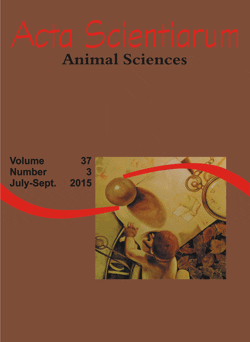<b><i>In vitro</i> degradation and gas production of glycerin generated in the biodiesel production chain
Abstract
This study was realized to evaluate the production of gas and volatile fatty acids when glycerin was used to replace four forage species through the use of a semi-automated technique in vitro. The experimental design included 4 treatments and 4 replications. The treatments consisted of increasing levels of glycerin (0, 30, 50 and 70%), which was used to replace the forage plants Elephant grass, sugar cane silage, corn silage and Brachiaria grass. Replacement of the Brachiaria and Elephant grasses with glycerin linearly reduced the production of methane and carbon dioxide and ammonia nitrogen and had a positive effect on forage quality (p < 0.05). With the addition of glycerin, the values for acetate concentration decreased (p < 0.05); however, when added glycerin there was increased in propionic and butyric acid concentration (p < 0.05). Substitution of forage species for glycerin by tests for semi-automatic technique in vitro reduce the production of greenhouse gases (CH4 and CO2) which reduction in energy loss, and increase volatile fatty acids propionic and butyric.
Downloads
DECLARATION OF ORIGINALITY AND COPYRIGHTS
- I Declare that current article is original and has not been submitted for publication, in part or in whole, to any other national or international journal.
The copyrights belong exclusively to the authors. Published content is licensed under Creative Commons Attribution 4.0 (CC BY 4.0) guidelines, which allows sharing (copy and distribution of the material in any medium or format) and adaptation (remix, transform, and build upon the material) for any purpose, even commercially, under the terms of attribution.
Read this link for further information on how to use CC BY 4.0 properly.








































